telegraphic codes and message practice
scanned code directory
cotton codes
This page is another step in a redistribution (and expansion) of content in my scanned code directory project. It contains notes and selected images of codes that are entirely or primarily devoted to cotton. Some of these are available as scans; others are not, and are drawn from my own collection or from copies in libraries. This is a work in progress.
1846 John Wills, Electro-Magnetic Telegraph Vocabulary; or, Condensing Correspondent
1868 O. B. Graham & Co.’s Telegraphic Code, New Orleans
1871 Private Telegraphic Code. R. G. Musgrove & Son.
1871 Code [of abbreviations to be used in business telegrams, by W. W. Biggs]
1872 Watts’s Telegraphic Cypher
1874 Thos. Trout & Sons, Telegraph / List of Telegraph Key Words
1875 Watts’s Telegraphic Cypher, Revised Edition
1875 Cotton Telegraph Code (Cutter Tower & Co., Boston)
1875 Telegraphic Cypher Code (of Lehman Bros., New York, et al.)
1877 Telegraphic cypher of Julius Büttner, Mobile Alabama.
1878 The Cotton Telegraph Code, with ciphers not exceeding ten letters (38th Edition, Meyer)
1878 Telegraphic Cipher Code, Especially Adapted to the Cotton Trade (Shepperson)
1880 International Telegraphic Code (J.A.D. Watts)
1881 The Standard Telegraphic Cipher Code for the Cotton Trade (Shepperson)
1888 Private Cable Code (Geo. H. McFadden / Philadelphia and Frederic Zerega /Liverpool.)
1926 Howard Cotton Code (C. B. Howard, Jr.; Memphis)
1942 Telegraph Code (spot cotton markets / Agricultural Marketing Administration, USDA)
I expect to redistribute this concent to two or more pages, perhaps initially for codes from the 19th and 20th centuries, respectively.
More cotton codes exampled here.
See in particular the Private Cable Code (1888) used by Geo. H. McFadden & Bro. Philadelphia and Frederic Zerega & Co. Liverpool.
Where examples are taken from digitized scans, they are generally cropped to favor text block; no attempt is made to guess margin sizes. Some examples are taken from copies in a private collection: these will show entire page and page spreads.
intro
Cotton was the subject of domestic and international communication, and appears in the earliest telegraphic codes. Cotton growing and transportation was a huge industry, and the classifications, qualities, amounts, and different shipment arrangements — while many — were well suited to systematic presentation in tables. Tables afforded message senders and receivers a panoptic view of specific topics, and a disciplined way of framing their communications.
One feature of many cotton codes (but not limited to them) is that they involve protocols of message assembly/unpacking. For example, the Watts telegraphic codes of 1872 and 1875 involve assembling messages figure by figure, in a specific order (e.g., cost and freight, price, quality, quantity), which might then be rendered (condensed) into a codeword/cypher for transmission. Formulaic composition also had the advantage of limiting the risk of ambiguities in communication, where the stakes (in terms of capital at risk) could be enormous.
Commodities codes contained tables and phrases, with some codes (Meyer, Buenting) predominantly tabular. One might not need to include any phrases at all in assembling messages from a well-compiled specialized code, in communication with an experienced counterpart.
The physical activity of locating the right meanings/codewords in large typographical arrays of message molecules — whose architecture is visible — is perhaps foreign to us now, where such architectures are hidden in hardware and software. This is a reason for us to see the codes, see their variety and, if possible, handle them in their physical forms.
One imagines that a manager or cable clerk might have quietly enjoyed wrapping intelligence about cotton transactions, into unlikely expressions like Duodenum, Dusthole and Dysentery.
| 1846 | Electro-Magnetic Telegraph Vocabulary; or, Condensing Correspondent, designed to communicate commercial and other general intelligence, in Abbreviated Form and at Small Expense. | general (including cotton) | Baltimore John Wills Printed by John W. Woods | no scan copy at American Institute of Physics |
66, 16 p.; 17 cm..
Niels Bohr Library, Center for History of Physics, at the American Institute of Physics, (Z)KT WILChiefly tables.
A fair amount of this item is manuscript, possibly in preparation for a later edition.
Images below provided by, and shown here with the gracious permission of the Niels Bohr Library, Center for History of Physics, at the American Institute of Physics.
 |  |
| title page, and page 40, John Wills Telegraph Vocabulary (1846) |
I am showing pages out of sequence, to better explain how the code was organized. A table for upland cotton, shown above, shows a column of root words (Steam,
Step
) to which prefixes and terminusses
are affixed. The completed codeword is a kind of formula containing a particular set of facets about a transaction.
See the instruction at page 39 below, for how some of this works.
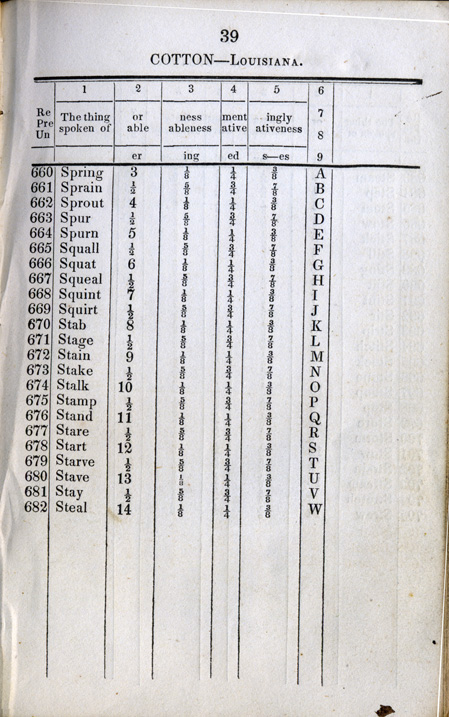 | 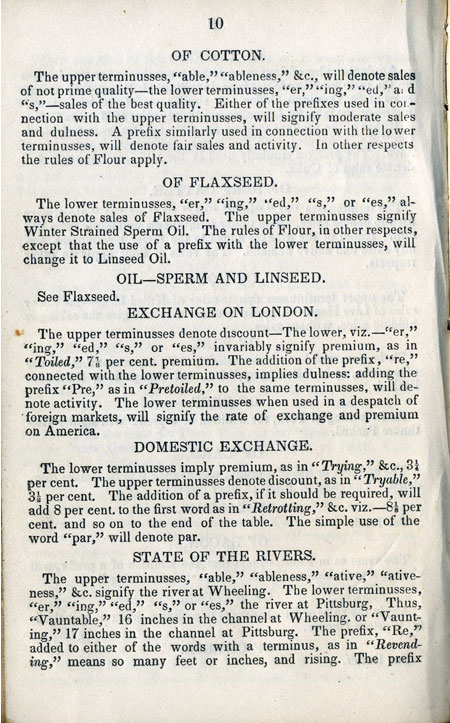 |
| pp39 and 10 (not spread), John Wills Telegraph Vocabulary (1846) |
In brief: the prefixes (Re, Pre, Un) indicate tendencies in the market;
next column: upper terminusses (or, able) indicate non prime qualities, and lower terminus (er) indicates best quality.In other respects the rules of Flour apply
refers to those rules given in seven paragraphs on pp7-8 (and not shown here — a transcription will follow.
Wills gives these specimens of common usages of his code (p2) —
| Abated, Fortieth, | Sales of $15,000 U.S. 6’s at an advance of 1/2 (indistinct) of one per cent, on sales of yesterday or previous sales. |
| Bibing, Thirteenth, | Sales of 13,000 bbls. Genesee flour at $5 56 1/8 (indistinct) |
| Fixers, Sixty, | Sales of 60,000 bushels prime red wheat at 92 a 95 cts. per bushel. |
| Effacers, Fourteenth, | Sales of 14,000 bushels prime yellow corn at 67 a 70 cts. per bushel. |
| Laughing, | Sales of New Orleans sugar at 7 1.2 cts. per lb. |
| Paves, | Sales of New Orleans Molasses, at 33 1/2 (indistinct) cts. per gallon. |
| Printing, | Sales of Laguayara cofee at 8 1/2 (indistinct) cts. per lb. |
| Sawing, | Sales of Western mess pork, at $11 12 1/2. |
| Standing, Tenth, | Sales of 10,00 bales Louisiana cotton, best quality, at 11 1/2 cts. per lb. |
What is important in this code is the arrangement of message molecules
— differing facets, shadings, prices, etc. — in tabular form. Two benefits are: (1) panoptic view of a subject; and (2) compression of many potential sentences (that would require many pages) into a single page. We will see many tables in cotton — like other commodities — codes, including those listed and discussed on this page.
John Wills also compiled Telegraphic congressional reporter.
Baltimore: : Printed by John W. Woods., 1847.
81 p. ; 14 cm. (3 1/2 x 5 1/2 inches)
No cotton! But quite interesting; for example, it provides boilerplate phrase-length descriptions, sometimes encomiastic, of great senators’ speeches and styles of delivery.
| 1868 | O. B. Graham & Co.’s Telegraphic Code, New Orleans, 1868 | cotton | Manchester | google BL 8756.cc.8 |
Manchester: Palmer & Howe, Printers, 1 & 3, Bond Street.
original at BL (8756.cc.8, accession 14 October 1868)
Index and example (unnumbered p1); General Advices and Market Reports pp 5-7; Quantity Ordered or Purchased pp8-9; Classifications pp10-11; Limits or Quotations in Pence Sterling pp12-16; General Instructions pp 17-19; Freights pp20-21; Crop Advices and Estimates pp23-24; blank p25; Numerals pp26-30; blank p31.
| 1871 | Private Telegraphic Code. R. G. Musgrove & Son. | cotton | New Orleans and Liverpool. | google Bodleian 25789.e.2 |
New Orleans and Liverpool.
Liverpool: Joseph A. D. Watts and Co. Printers.
original at Bodleian (25789.e.2, accession 31 July 1884)
40 numbered pages, all recto; verso pages unnumbered. Recto pages contain tables and phrases; verso pages provide 12 codewords with empty space for phrases. Presumably, the latter would pertain to the topics covered on the facing recto page.
Table 1 : Number of Bales, and price per lb, cost, freight and insurance. (pp 1-2)
Table 2 : Number of Bales and price per lb, laid down on quay, in Liverpool. (pp 3-5)
Numbers and Number of Bales (pp 5-6)
Fractions, decimals, per cents; price per lb. (p7)
Advice of Terms of Orders (p8)
Classifications (p8)
Classifications 10 columns x 13 rows (p9)
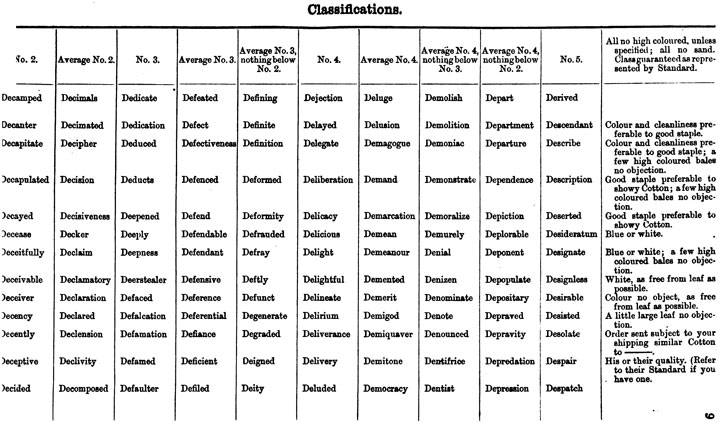 |
|
| page 9 (margins cropped, and rotated 90 degrees), Private Telegraphic Code. R. G. Musgrove & Son. (1871) | |
Liverpool Classifications (p10)
Examples provide for quotations for 1, 2, 3, 4, 5 and even six classes, by expressing quote for first grade, and differences from that for each of the succeeding (and progressively lesser) grades. Suggests that figures can be cabled as such (which was probably not safe). Quotations. (phrases) (p27)
London Consists of an I assembled my own table of contents (below), without reference to that in the book, as a means of carefully examining every section of this code. Subsequently I adjusted my version to incorporate the Not having examined physical copies of this code, I cannot account for missing pages, e.g., pages 3 – 6.
Sundry Advices of Style, &,. (quality, description) (p11)
Advice of Staple and Colour (8 columns x 19 rows) (p12)
Advice of Style of Purchases (p13)
Advice of Buying (p14)
Advice of Shipping (p15)
Advice of Orders (p16)
Alteration of orders, discretion and altering limits, time in force and cancelling. (p17)
Inquiries.—Liverpool to New Orleans. (pp 18-19)
Advice of Firm Sales. (p19)
Answers from New Orleans to Liverpool. (p20)
Sundry Advices.—New Orleans to Liverpoo.
Quotations, including cost, freignt and insurance. (table) (pp23-25)
Rules for Quotations. (p25)
Examples of Quotations. (p26)
Example in case of excessive dearness. (where whole quotation is (to be raised) 10 pence per lb.
) (p26)
Complaints of Shipments. (p27)
Advice of Letters. Advice of Cables and Cypher. (pp 28-29)
Advice of Market (3 cols New Orleans, Liverpool, Manchester) (p29)
Advice of Market. (1 col) (pp 30-31)
Advice of Sales and Firm Offers only. Number of Bales and price per lb, including cost, freight and insurance, and 6 per cent loss in weight. (pp 31-33)
Advice of Crop, Supply, Receipts and Exports. (pp 34-35)
Advice of Ships and Freights. (pp 35-36)
Advice of Drafts and Standing of Firms. (pp37-38)
Sundries. (sentence fragments, e.g., all same,
all right,
and Scientific / Divide into lots.
(pp39-40)
1871
Code [of abbreviations to be used in business telegrams, by W. W. Biggs] cotton London google
Bodleian 25789 d. 151
combined BL and Bodleian information as follows:
Notes: Interleaved.
Format: cm.25.
Physical Description: xi, 85 p. ; 4º.
BL Shelfmark: General Reference Collection 8247.g.25.abbreviated code
pp 1-22 and a constructive code
pp 23-85. The division recalls the structure of nautical signal codes, with one, two, three (and so on) flag vocabularies, with the easier-to-work-up vocabularies reserved for time-critical messages. The abbreviated code is for quick assembly of orders, firm offers and bids.species of cipher
and other details in the original. The typographic presentation of the Index, and elsewhere throughout the book, is exemplary.
pages
chapter, section title, comments
ciphers
i – ix
Alphabetical Index
all cipher words
x – xi
General (topical) Index
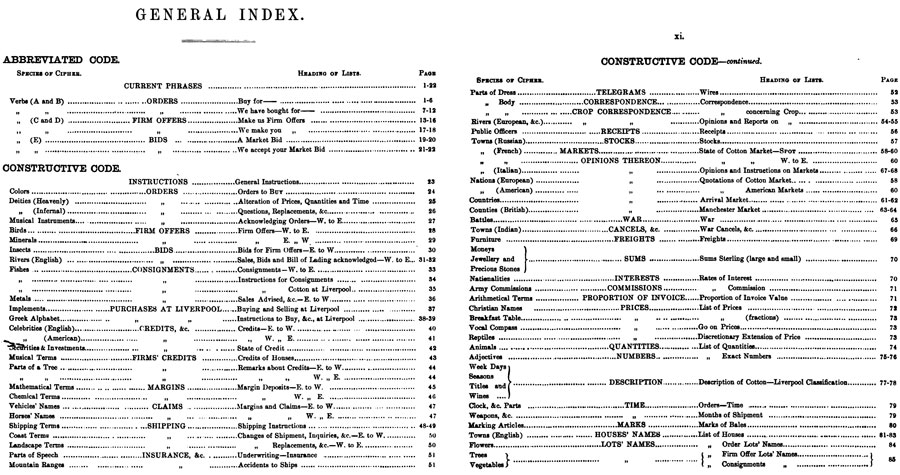 |
|
| pages x and xi Biggs Code (1871) |
|
| 1 – 2 | Abbreviated Code East to West — Current phrases Buy for... |
verbs whose initial is A |
|
| 7 – 12 | Abbreviated Code West to East — Current phrases We have bought... |
verbs whose initial is A |
The Abbreviated Code would involve use of three ciphers:
Abandon / Buy for
[unnamed account — John ?] 100 bales average Middling shipment from Savannah if at
(for example) Beatrice / 6 3/8 or 10 3/8 pence (per pound), using the price that is consistent with current market. The presentation of two (and even three) prices for a single cipher is called a partical
prices, and is commonly found in commodities codes.
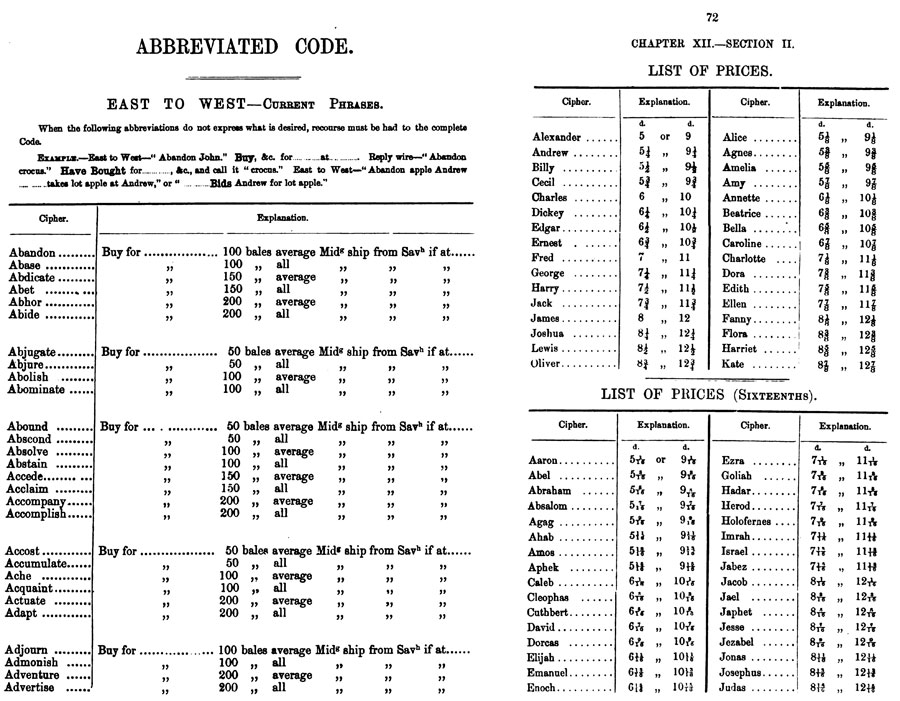 |
|
First page of Abbreviated Codeand p72 prices(cropped; not spread), from Biggs Code (1871) |
|
| 13, 18, 18A, 18B | About Firm Offers — East to West for reply day after to-morrow |
verbs whose initial is Cand D |
|
| 19 – 20 | Market Bids — East to West | verbs whose initial is an E |
|
| 21 – 22 | Replies to Market Bids — West to EastWe accept... |
verbs whose initial is an E |
|
| 23 | I I | General Instructions; Orders going West | |
| 24 | Orders | colors | |
| 25 | I II | Alterations of prices, quantities, —... | deities (heavenly) |
| 26 | I III | Questions, replacements, &c. | deities (infernal) |
| 27 | I IV | Acknowledging orders — West to East. | musical instruments |
| 28 | II I | Firm offers — West to East. | birds |
| 29 | II II | Firm offers — East to West. | minerals |
| 30 | III I | Bids — East to West. | insects |
| 31 – 32 | III II | Sales and bids acknowledged — West to East. | rivers (English) |
| 33 | IV I | Consignments — West to East. | fishes |
| 34 | IV II | Instructions for consigments — West to East. | fishes |
| 35 | IV II | continued. Instructions — for cotton at Liverpool. Note two Discretion Signalsat bottom of page. |
fishes |
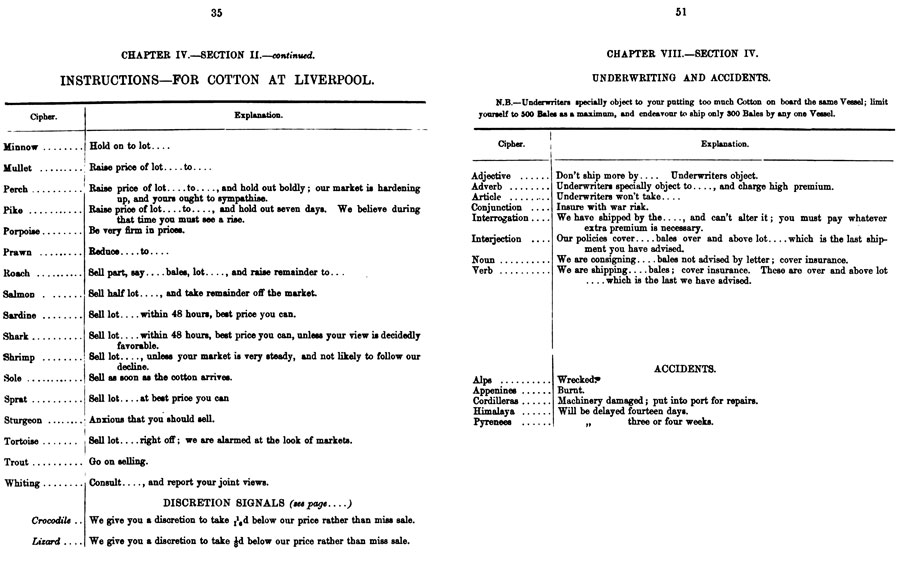 |
|
pages 35, 51 of Constructive Code,Biggs Code (1871) Note the so-called Discretion signalson p35. |
|
| 36 | IV III | About consignments — East to West. Sales advised, &c. | metals |
| 37 | V I | Shall we buy for you? |
implements (tools) |
| 38 | V II | Instructions to buy at Liverpool, &c. | Greek alphabet |
| 39 | V II | continuedBuy distant arrivals |
Greek alphabet, among others |
| 40 | VI I | Credits — East to West. | celebrities (English — men of letters, statesmen) |
| 41 | VI II | (credits) East to West | celebrities (American — men of letters, military figures) |
| 42 | VI III | State of Credit. | securities and investments |
| 43 | VI IV | Credits of Houses. | musical terms (e.g., Allegro, Andante) |
| 44 | VI V | Remarks about Credits — East to West. | parts of a tree |
| 45 | VII I | Margin Deposits — East to West. | mathematical terms |
| 46 | VII II | Margin Deposits — West to East. | chemical terms |
| 47 | VII III | Margins and Claims — East to West. | vehicles’ names, horses’ names |
| 48 | VIII I | Shipping Instructions. | shipping terms (nautical expressions) |
| 49 | VIII II | Ready to ship, ship named, etc.continuation. |
shipping terms |
| 50 | VIII III | Shipments | coast terms (coastal/port infrastructure, topological features) |
| 51 | VIII IV | Underwriting and Accidents. | parts of speech, mountain terms |
| 52 | IX I | Wires | parts of dress (articles of clothing) |
| 53 | IX II | Correspondence (including views on crops). | parts of body (anatomical) |
| 54 – 55 | X I | Crop — Opinions and Reports thereon. | rivers |
| 56 | X II | Receipts | public officers |
| 57 | X III | Stocks | towns (Russian) |
| 58 – 60 | XI I | Quotations of Cotton Market. State of Cotton Market — Spot. | towns (French — European toponyms, followed by North American toponyms for Quotations of American Market) |
 |
|
| pages 23 and 60 Biggs Code (1871) | |
Note the elaborate instructions, definitions, advice, reminders.
| 61 – 62 | XI II | Arrival Market. | toponyms |
| 63 – 64 | XI III | Manchester Market. | toponyms |
| 65 – 66 | XI IV | War. (Rumors, panics, etc.). War Cancels, &c. | battles (toponyms); also India (toponyms) |
| 67, 68, 69 | XI V | Opinions and Instructions on Markets; Freights. | toponyms |
| 70 – 71 | XII I | Sums Sterling, Rates of Interest. Proportions of Invoice Value, Rates of Commissions. | moneys, jewellery and precious stones; nationalities, respectively |
| 72 – 73 | XII II | List of Prices. | Christian names; breakfast table; vocal compass; reptiles |
| 74 | XII III | List of quantities. | animals |
| 75 – 76 | XII III | (continued). Exact Numbers. | adjectives, adverbs |
| 77 – 78 | XII IV | Description of Cotton — Liverpool Classification. | days of the week, names of seasons (in English and French); wines and spirits |
| 79 | XII V | Orders — Time. Months of Shipment. | clocks, &c. parts; weapons &c. |
| 80 | XII VI | Marks | marking articles (paint, glues) |
| 81, 82, 83 | List of Houses. With one exception (Middleton / The Market), blanks to be filled in. |
towns (English) | |
| 84 | XII VIII | Names of Order Lots. | flowers |
| 85 | XII VIII | List of Firm Offer and Consignment Lot. | trees, vegetables |
This code appeared early, and is pretty fully elaborated for its purpose.
| 1872 | Watts’s Telegraphic Cypher | cotton | Liverpool, Joseph A. D. Watts | google Bodleian 196.e.20 |
Liverpool: Printed and Published by Joseph A. D. Watts, 1872
At Bodleian (196.e.20)
in three parts, as summarized below —
- a table (pages 1-66) containing the figures 100 / aachen through 9999 / tippenac;
These figures are to be assembled in this order —
first figure indicating cost and freight, per steamer or sail, or cost, freight and insurance, per sail;
second figure indicating price;
third figure indicating quality; and
fourth figure indicating quantity; - followed by appendix —
dictionary furnishing words for the numbers,but these words must be restricted solely to the use in connection with the numbers as to be constructed on the basis of the table
—
Appendix A pp68-69 cyphers rising every sixteenth;
Appendix B numbers 5 / transitcircle through 5,000,000 treviglio; - and continuation of appendix as follows —
c. Descriptions and classifications of cotton.
d. Quotations.
e. A set of cyphers for shipments from the different parts of the United States
f. Cyphers for the transmission of orders, increasing, reducing, or other remarks about limits.
g. Remarks about firm offers.
h. Consignments and advances.
i. Freights.
k. Insurance.
l. Limits for time and duration of firm offers.
m. Shipments.
n. Crop accounts.
o. Market reports.
p. Contracts for forward delivery.
q. Monetary drafts, credits, etc.
 |
|
| preface (pp iii-v), Watts’s Telegraphic Cypher (1872) | |
—
 |
|
| pp72-73, Watts’s Telegraphic Cypher (1872) | |
| 1874 | Thos. Trout & Sons, Telegraph List of Telegraph Key Words | cotton | Liverpool, Joseph A. D. Watts and Co. | no scan, BPL 5969.21 |
BPL catalogues this as Memphis, Tenn. N.D., no title page. 7pp. 16°
Penned on first page is the name of James A. Duped, date Aug. 29, 74.
Thos. Trout & Sons appear to have been an agent or broker located in Memphis, in a Federal case in 1859 involving a shipment of 201 bales of strictly middling
cotton from Cairo, on to Memphis and Boston (here). Details: a barge bearing the cotton from Cairo to Memphis had docked at Memphis; shortly therafter, a fire was discovered in which a very considerable portion of the cotton was consumed.
The question regarded liability.
This code must certainly have appeared after 1866 (owing to mention of cable
news (see codeword Ginger and before 1874.
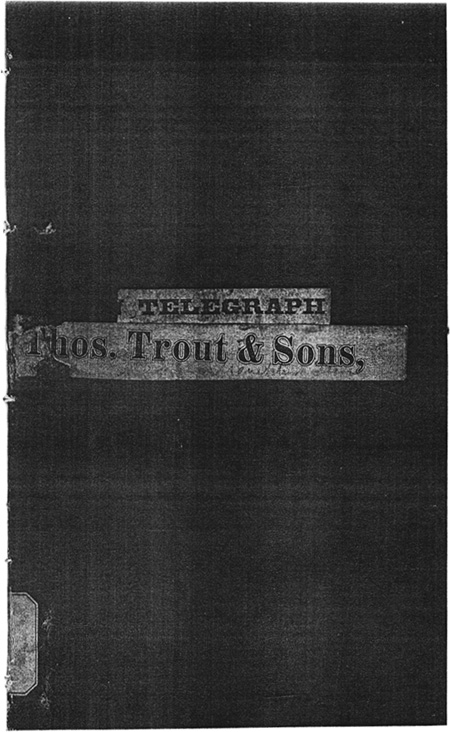 | 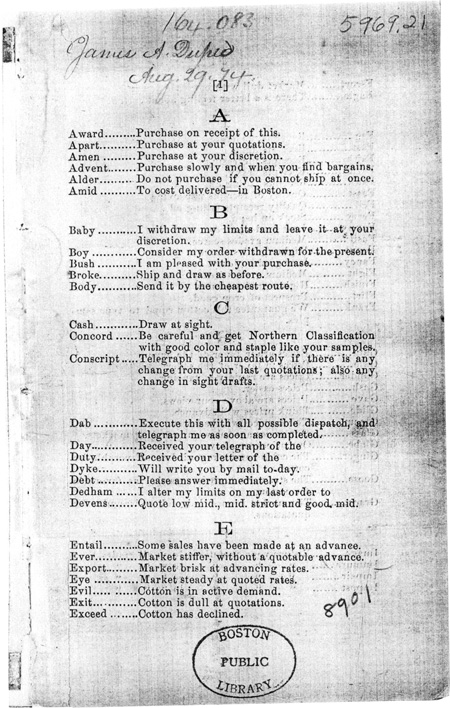 |
| title/cover page, and first page (from poor photocopy), Thos. Trout & Sons, List of Telegraph Key Words (1874?) |
No table of contents; code follows convention by which topics are suggested by initial letters of codewords.
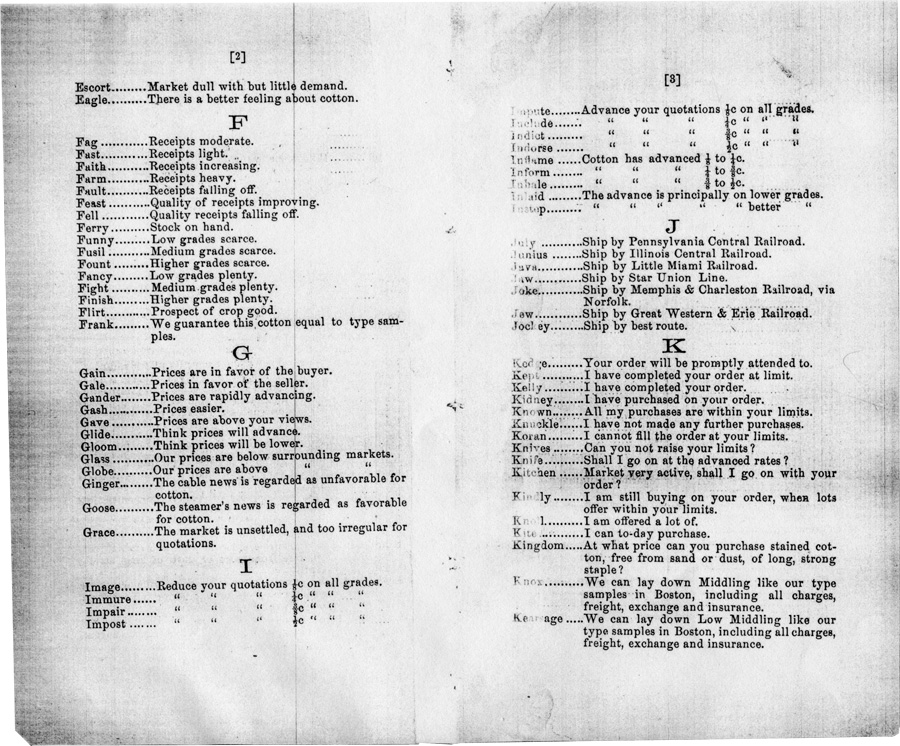 |
|
| pages 2-3 (from poor photocopy), Thos. Trout & Sons, List of Telegraph Key Words (1874?) | |
| 1875 | Telegraphic Cypher Code | cotton | Lehman Bros., New York. | no scan, private collection |
Telegraphic Cypher Code of Lehman Bros., New York, Lehman, Abraham & Co., New Orleans, Lehman, Durr & Co., Montgomery, Ala.
[1-4], 5-69, [15 unpaginated blank pages]
4 1/4 x 6 3/4 inches, boards.
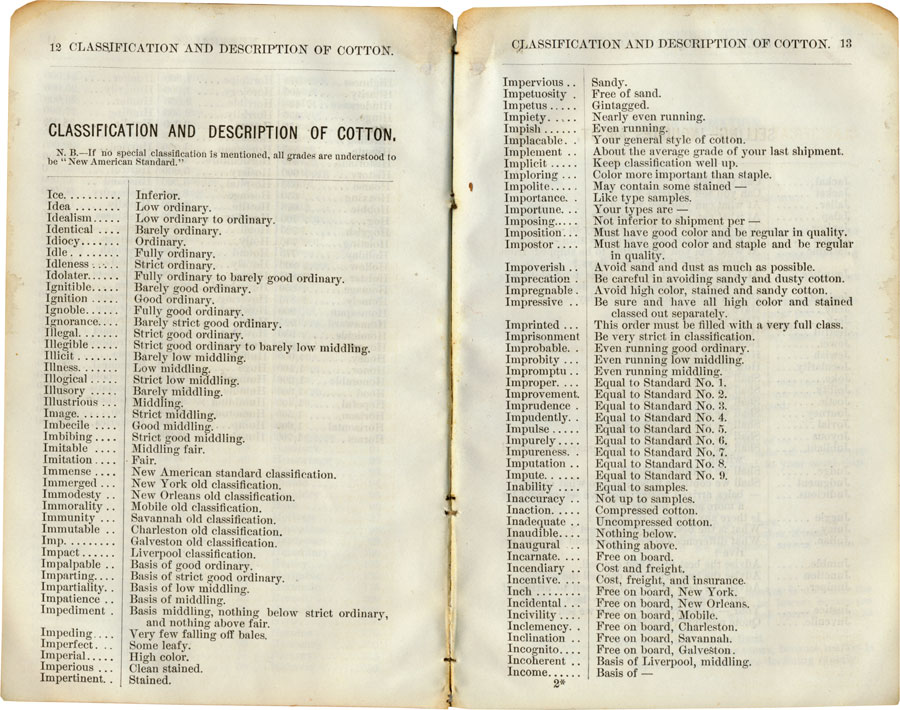 |
|
| pp 12-13, Telegraphic Cypher Code of Lehman Bros. (1875) | |
Cotton was the original business of Lehman Brothers. Classification and description were all-important: a bale of cotton — compressed — weighed up to 500 pounds, and might be worth (depending on classification and quality, and year!) $40 and up to $80 a bale (cotton was priced by the pound). Classifications, and fine shadings, mattered a lot where so much capital was at stake, samples could not be FedEx’ed overnight.
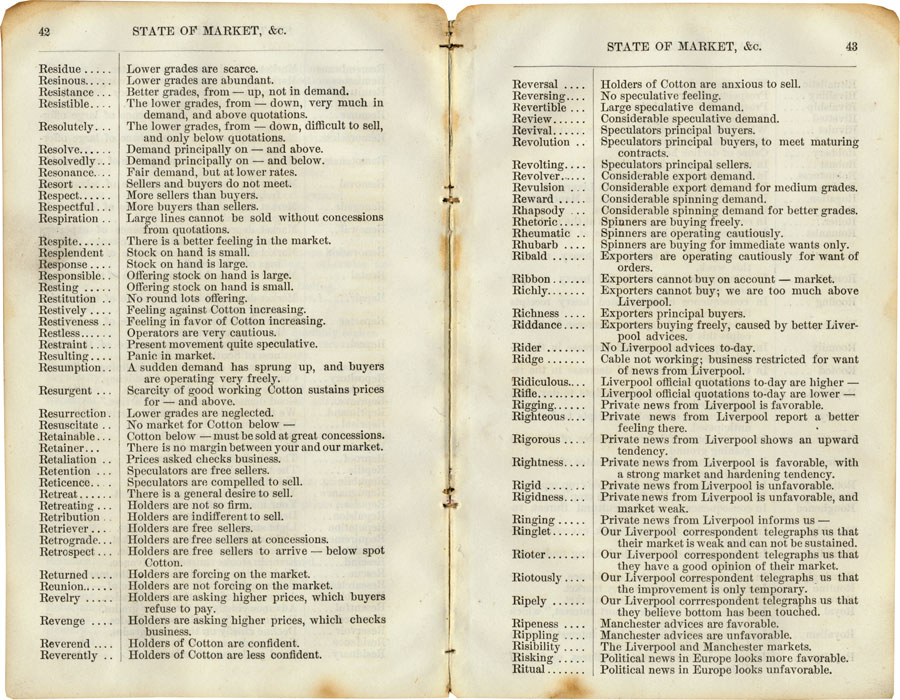 |
|
| pp 42-43, Telegraphic Cypher Code of Lehman Bros. (1875) | |
There are more gradations, however, of market sentiments, than there are of cotton — at least for Lehman. Here are but two of six pages under the heading State of the Market, &c. These are followed by five more pages of
Opinion
about the market, including actions (real and anticipated) by operators
and combinations.
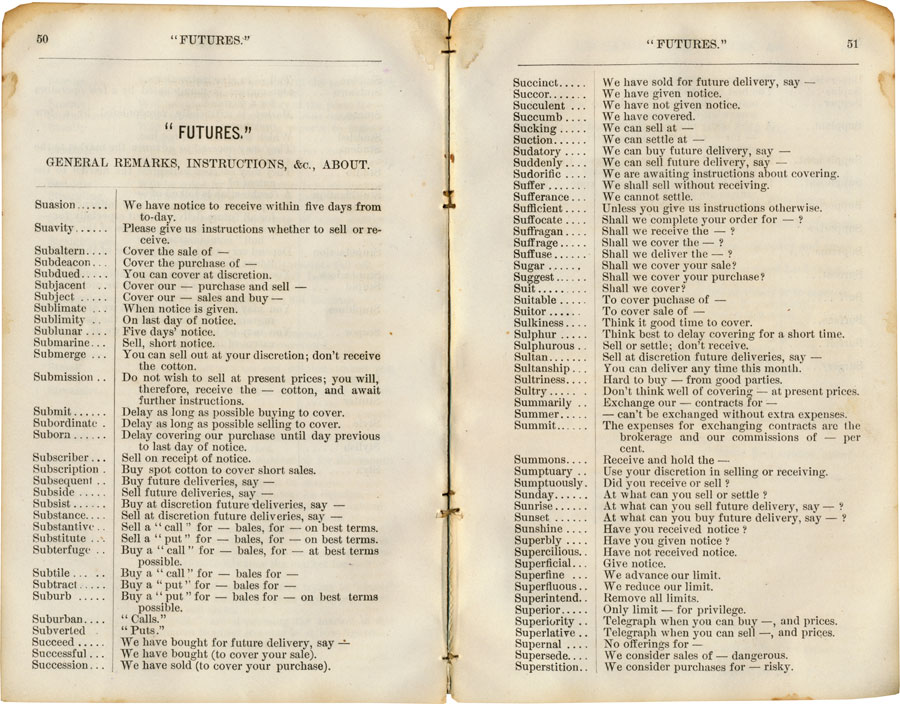 |
|
| pp 50-51, Telegraphic Cypher Code of Lehman Bros. (1875) | |
Two passages from the preface —
When no cypher of quality is used, the Cotton to be bought or sold is on basis of Middling, American Standard Classification.
andIn sending the first message from this Code please prefix the Cypher
Tumefy,
that we may understand you have received and are using this book.
| 1875 | Watts’s Telegraphic Cypher, Revised Edition
In words of ten letters to suit the regulations of the St. Petersburg Convention. | cotton | Liverpool, Joseph A. D. Watts and Co. | google Bodleian |
This revision of the 1872 code was undertaken to bring codewords down to 10 letters and under. The compiler took this as an opportunity to introduce an important additional change: the introduction of pre-composed tables each devoted to a separate topic. The 1872 edition had, although it was not stated, expected such tables to be assembled by the users. The new tables follow the title page and precede the preface, but are only partially visible in the Google scan of this Bodleian copy. They are —
- the original Table 1 (following the preface, and with revised codewords), for figures 100 through 9999;
prices of Cotton per steamer and per sailing vessel, at a stretch of 2 13/16d, and one hundred variations of quality;
market reports, both Spot and Arrival;
quantities and prices of goods to arrive, and can be used only in conjunction with Tables 2 and 3;
Quantities and Time Limit, and can be used only in conjunction with Table 2;
purchaser’s names, limit of time, and reimbursement arrrangements.
Shown below are the four tables that are partially exposed in the Google scan.
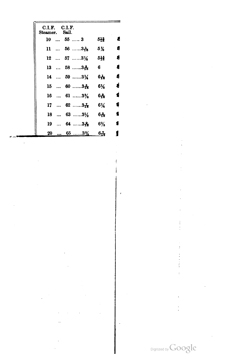 |
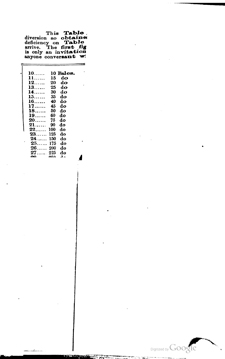 |
 |
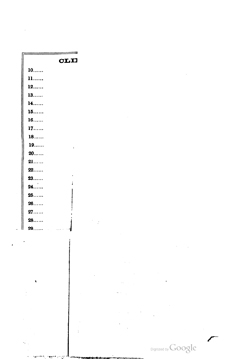 |
| fragment of table 2 | fragment of table 4 | fragment of table 5 | fragment of table 6 |
The new arrangement in most instances is expected to dispense with the need for the phrases arrayed in the second part of this and the earlier edition. Further, even the original Table 1 would not frequently be used, now that new tables are provided (providing dictionary words representing 4 figures for all entries). The last paragraph of the preface explains how one might indicate the order in which Tables shall come into play
— exampling the figure 136, indicating that Tables 1, 3, and 6 are to be used, in that order.
The Editor has also compiled Tables for General Produce, say Lard, Bacon, Grain, Petroleum, &c. which will be supplied gratis with the code, and which will explain themselves.
One further improvement was a Detector
(pp 106-107), showing likely Morse errors.
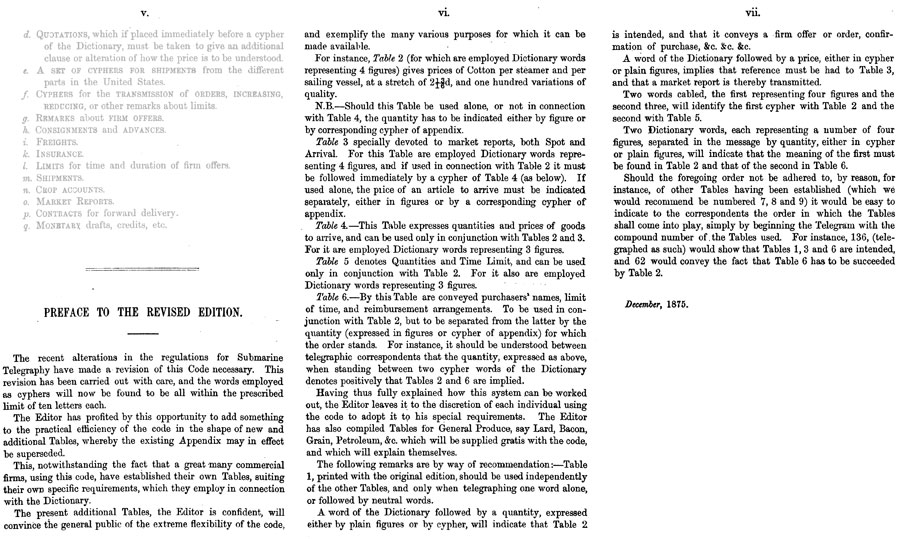 |
|
| ppv-vii (passage repeated from 1872 edition grayed out), Watts’s Telegraphic Cypher (revised, 1875) | |
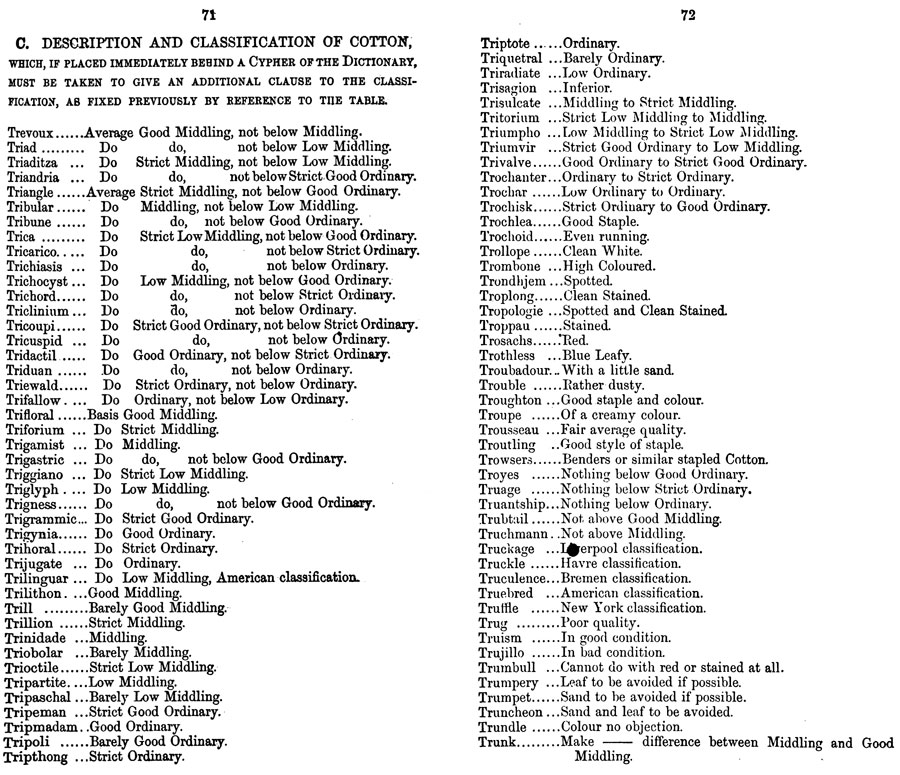 |
|
| pp71-72, Watts’s Telegraphic Cypher (revised, 1875) | |
The pages shown above differ from their predecessors in the 1872 edition in codewords (shortened), but also in an increase in the number of phrases (and codewords). Taking Table C. alone, 72 entries in the 1872 edition expand to 120 (covering three pages) in the 1875 edition. There are quite a few additions in qualities, e.g., Tropologie / Spotted and Clean Stained. Long codewords are replaced by shorter ones: Triacontrahedral and Tschirnhausen give way to Triad and Tscherkask.
| 1875 | Cotton Telegraph Code | cotton | Cutter, Tower & Co, Manufacturing Stationers | no scan BPL 3969a.204 |
24pp, 17cm high.
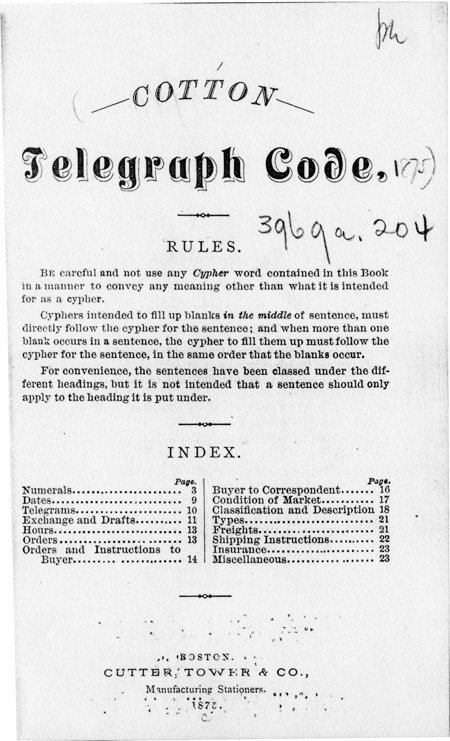 | 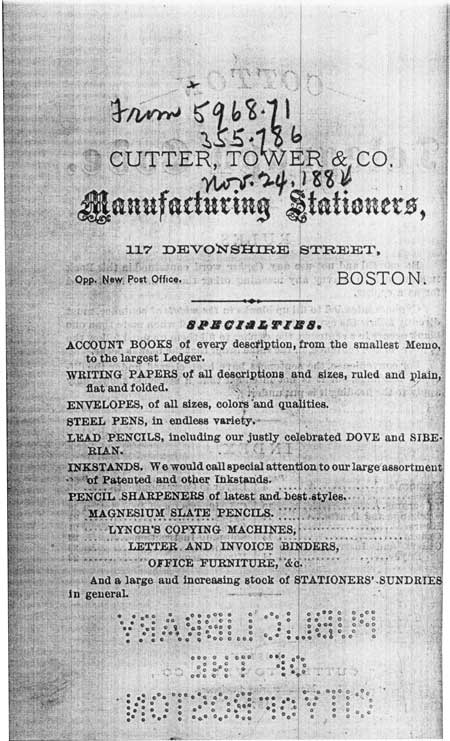 |
| title/cover page, and obverse p2 (from poor photocopy), Cotton Telegraph Code (1875) |
So, would this manufacturing stationer
work up such codes, or publish them for a customer who was a cotton broker? Something about Cutter, Tower can be gleaned from a memorial notice on Levi L. Tower, in Walden’s Stationer and Printer 35 (1912) (here). His activities outside of stationery included a cotton gin business.
No tables
in this code, only phrases (and numbers/fractions).
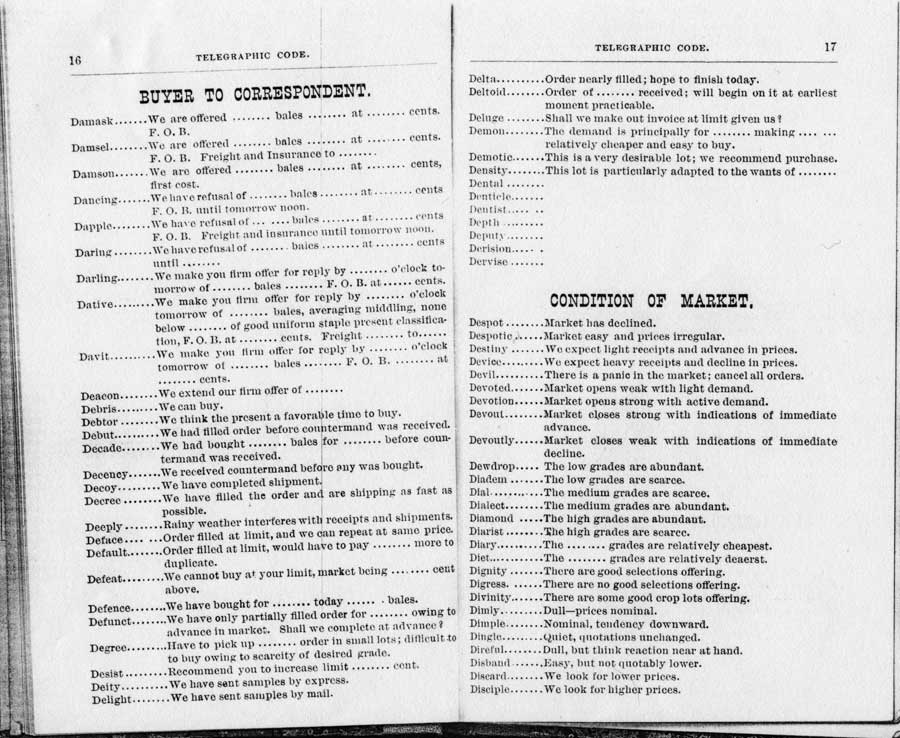 |
|
| pp16-17 (from poor photocopy), Cotton Telegraph Code (1875) | |
English dictionary codewords.
| 1877 | Telegraphic cypher of Julius Büttner, Mobile Alabama. | cotton, rosin | Mobile: Prices-Current Job Print. | google NYPL |
no tables
Examples the earlier practice in which different topics are indicated by codewords with respective initial letters, e.g., A for Quantities or Numbers,
E for Insurance and Freights,
and T for Miscellaneous.
Also of interest is the instruction at p2 for the Rotation of my Daily Dispatches
.
| First Word | Day’s receipts | |
| Second Word | Price of Good Ordinary | Mobile Classification |
| Third Word | Price of Low Middling | Mobile Classification |
| Fourth Word | Price of Middling | Mobile Classification |
| Fifth Word | Freight to Liverpool | |
| Sixth Word | Market Report |
| 1878 | The Cotton Telegraph Code, with ciphers not exceeding ten letters... Thirty-third Edition, for the use of the American Cotton Trade | cotton | H. R. Meyer. Liverpool, Mawdsley & Son | google Bodleian 25789 d. 154 |
Meyer authored several codes. Some of these pertained to cotton; all were oriented to Liverpool trade. Will list some of these below.
The preface (including hints upon telegraphing
) runs four pages; it is followed by a check method (two pages, each cypher letter accorded a figure: take their sum and append it to the message in cypher form). Index pp xi-xx. The code proper runs pp 1-228. Codewords are dictionary words.
 |
|
| pp46-47 (cropped), Meyers Cotton (1878) | |
Shown above, table and phrases pertaining to quality.
 |
|
| pp124-125 (cropped), Meyers Cotton (1878) | |
Shown above, opinion
phrases, with ditto’ed ellipses for free-verse array.
| 1878 | Telegraphic Cipher Code — Especially Adapted to the Cotton Trade | cotton | Alfred B. Shepperson. New York | archive.org UC |
For domestic use; Shepperson’s Standard Telegraphic Cipher Code (1881) was conceived for international cabling.
| 1880 | International Telegraphic Code | cotton | Liverpool. J.A.D. Watts and Co. | google Bodleian (OC) 196 h.46 |
Printed and published by J.A.D. Watts and Co. Liverpool
Bodleian copy, (OC) 196 h.46
Consists of a two-page preface; followed by
Tables A (visible in this scan) and B (obscured by paper fold); and
the code proper, starting at page 1 (100 / aalbaum) and running through page 333 (99999 untertasse);
p334 Quotations for Limits, &c. (untervogt / 1/32) through page 335 (verdict 21 9/16);
page 336 Numbers (verdieping / 1 through verpligt / 6,000,000); and
pp 337 (Verpligten) through page 400 (ending with Wortfolge), these latter being spare codewords (63 pages x 30 ciphers = 1,890 total).
A codeword symbolizing five figures can fully exploit Table A. An example is given in the preface, for the cypher Internally, meaning 55495 :
| 5 | (first position) | March-April (or October-November shipment, according to date of transmission.) |
| 54 | (second position, consisting of two figures) | gives the price 6 1/4, C.I.F. steam (or 3 1/8, 4 11/16, 7 13/16, 9 3/8, according to market price). |
| 9 | (third position) | means Good Oomrawuttee, Fully Good Fair Clause. |
| 5 | (last position) | gives the quantity, 400 bales. |
 |
|
| Table A, International Telegraphic Code (1880) | |
Notice the use of partical prices
in the second position. These are cents/pence per pound, the exact figure taken as current market prices would indicate.
Table B. is obscured in the scan — evidently it is a folded page that was not opened. It is designed for the Brazilian Trade
but can be adapted to others, e.g., with India for Cotton and Produce together.
It seems also to allow for Market Reports, by incorporating some of the figures in the first position. The greater part of the code is given over to codewords and their figures; one column of the code/figure section is revealed below, where the table was not opened.
 |
|
| Table B, International Telegraphic Code (1880) | |
J. A. D. Watts seems to have been an important Liverpool publisher. A few titles are listed below. —
- 1867. W. H. Picton. Concerning doorways : a paper read before the Liverpool Architectural and Archaeological Society, 20th March, 1867 *
- 1870. W. H. Picton. French suburban villas : paper read at a meeting of the Liverpool Architectural and Archaeological Society, 23rd February, 1870 *
- 1873. Baron Louis Benas. Semitic legends: a paper read before the Literary and Philosophical Society of Liverpool, November 3, 1873.
other items in this volume printed by J. A. D. Watts. * - 1876. Henri Cernuschi. Silver vindicated *
- 1879. Samuel Smith. Bi-metallic money : a paper read before the Society for the reform and codification of the law of nations, on the 15th August, 1879 30 p. *
- 1879. Baron Louis Benas. The Influence of Artistic Races: An Address Delivered at the Invitation of the Liverpool Architectural Society, in the Royal Institution, Liverpool, 8th January, 1879 *
- 1879. Thomas Mellard Reade (1832-1909, *. How to drain a house : a paper read before the Liverpool Architectural Society, 29th November 1876 *
- 1881. Constitution, laws and usages of the Liverpool Cotton Brokers’ Association. *
- 1881. Samuel Smith (1836-1906). Free trade versus reciprocity. 30 p. ; 22 cm. *
From the Preface, this —
The success which attended the production of a former Code on the same principle in 1875, has induced the compilation of the present work on a more extended scale, in accordance with the Rules of the Eastern Telegraph Convention held in August last. // The Dictionary extends to 99,999, and offers the great advantage of a five Cypher Key, and as the numbering commences at 100 it also offers the further advantage of working a four Cypher Key. Cyphers are provided for Quotations and Limits, &c. and Numbers, also for phrases to suit individual requirements. // The two Tables, A and B, show the adaptability of the system, but as it is impossible to foresee the wants of every merchant, the Tables are simply given to show the manner of working, and it will be the task of every purchaser to arrange them to suit his special purposes.
| 1881 | The Standard Telegraphic Cipher Code for the Cotton Trade | cotton | Alfred B. Shepperson, New York, 1881 | archive.org Duke/Gessler |
306 pages, images below from 1908 reprint in private collection.
 |
|
| pp 30-31, Shepperson’s (1881) | |
| 1888 | Private Cable Code (for use between) Geo. H. McFadden & Bro. Philadelphia. Frederic Zerega & Co. Liverpool. July, 1888. | cotton | no scan private collection |
Liverpool: Turner, Routledge and Co., Printers. 6 3/4 x 10 inches; i-vii, 1-324
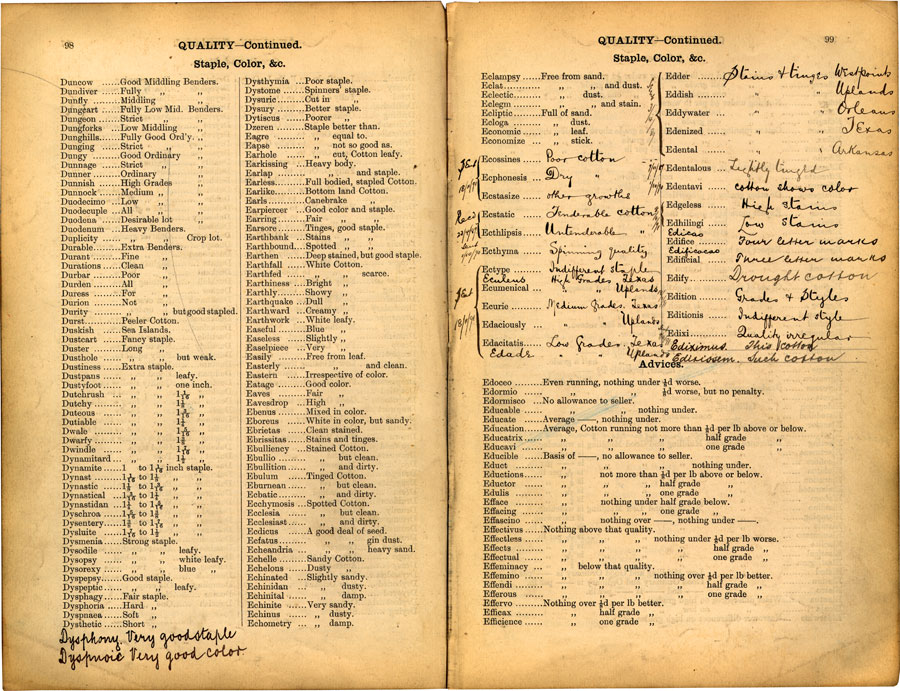 |
|
| pp 98-99, McFadden private code (1888) | |
Classifications and quality, with (dated) emendations. More of this code, and a cablegram that accompanied it, here.
| 1926 | Howard Cotton Code | cotton | C.B. Howard, Jr.; Memphis, Tennessee | no scan private collection |
204pp, 5 3/8 x 8 1/8 inches; terminal listings pp 136-204.
Typographic peculiarity: codewords are small caps for phrase selections, ordinary roman in tables.
The code is confident in presentation, and assumes familiarity with usage of codes.
Preface (p5) lists those expressions that require but 1 word.
I enumerate them here (they are not numbered in Howard) for convenience —
- Give or request an offer of Grade, Staple and Number of Bales (see Tables under heading
Offers
. - Indicate basis figures on, or off, any of the six active months (see Tables under heading
Basis
). - Note points of destination, and if ports, whether
Cost and Freight,
Shipside Standard Density,
Shipside High Density,
orShipside High Density, Delivery Uncompressed Interior
(seePoints of Destination
). - Any numeral from 1 to 4000 by unit.
- Fixed prices by single points and by sixteenths up to 40c.
- Express Grade, Staple and Quantity. To express Grade and Color or Grade and Character.
- Cancel offer of certain date or renew offer of certain date at same basis or 5 to 25 points higher or lower by five point variation.
- Arranging discretion by five point variations.
- Arranging allowances by five point variations.
- Indicating number of points, also points, higher, or points lower.
- Indicating percentage.
- Giving fixing instructions.
- Making counteroffers 5 to 25 points higher or lower by five point variation.
- Referring to letters by date.
- Indicate sailing and shipment and delivery.
- Giving amount of gain or loss in weights. Also reweights.
- Indicating sections of growth.
- Referring to any date of the year.
- Specifying commission in cents, points, or percentage.
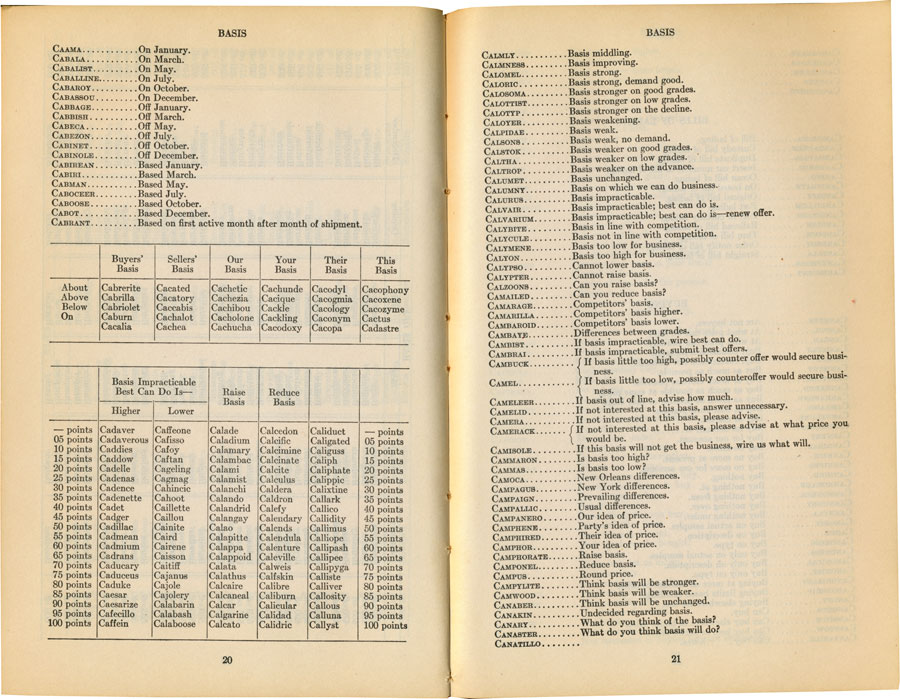 |
|
| pp 20-21, Howard Cotton Code (1926) | |
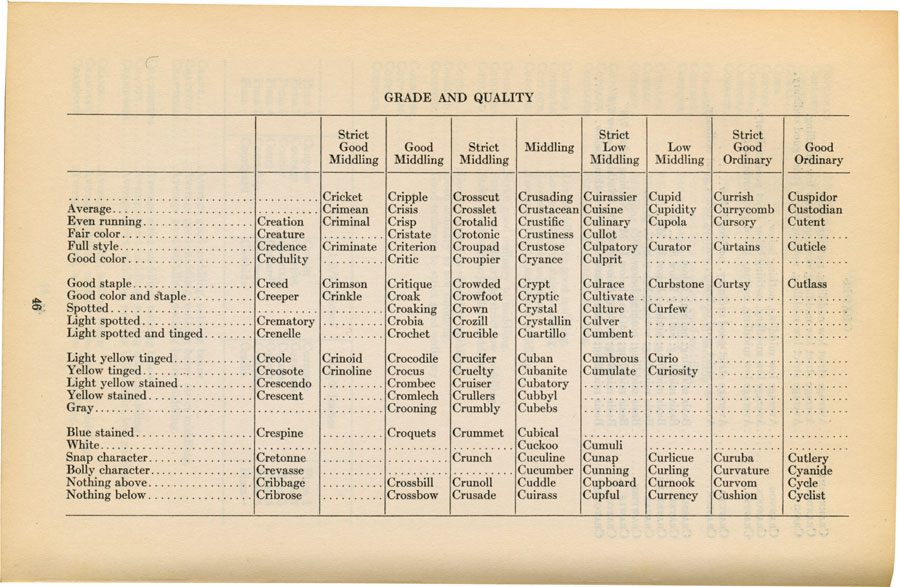 |
|
| p46, Howard Cotton Code (1926) | |
Lovely telegraphic code words: Creosote, Crinoline, Crocus, Cruelty... Cuckoo, Cumuli.
Nothing above Middling / Cuddle
Nothing below / Cribrose
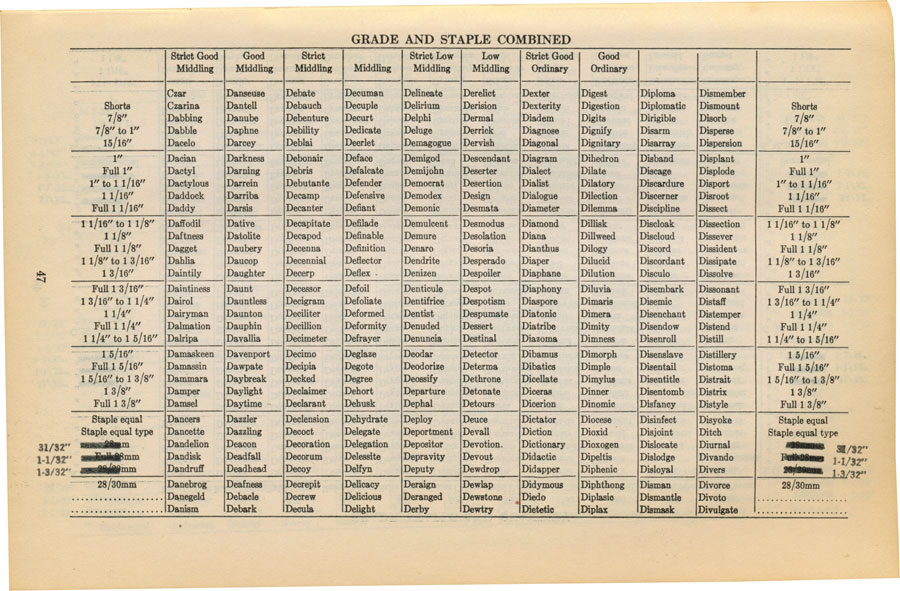 |
|
| p47, Howard Cotton Code (1926) | |
mm
overstamped by inches suggests the code might have been intended (in part) for cable (international) use. One code word describes grade and staple (average fiber length).
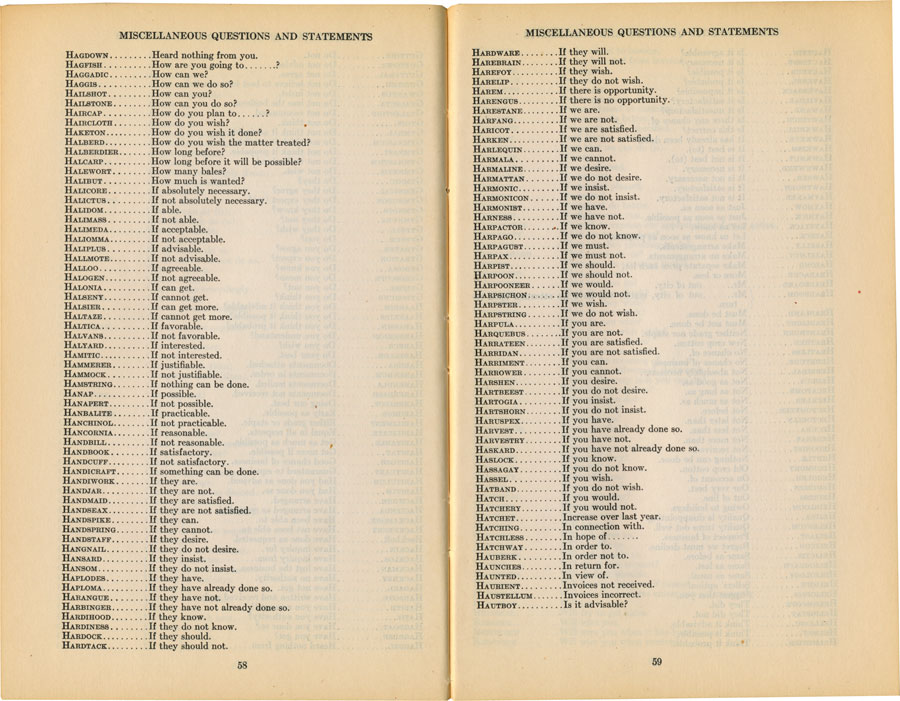 |
|
| pages 58-59, Howard Cotton Code (1926) | |
Miscellaneous phrases.
Hardware / If they will.
Harebrain / If they will not.
| 1942 | Telegraph Code For use between bona fide spot cotton markets and offices of the Agricultural Marketing Association | cotton | U.S. Department of Agriculture, Washington, D.C., July 1942 | USDA National Agricultural Library 1.942 C2T23 archive.org |
evidently 8.5x11 inches (mimeo, stapled); 10 pages (not counting cover provided by archive.org), which is not the 14-page imagecountindicated by archive.org | ||||
Title (i)
blank (ii)
Code (grade and color; staple) (iii)
blank (iv)
Instructions for use of code (v — or 1?)
General Terms (2)
(examples 1-2, in code and decoded) (4)
(examples 3-4) (5)
(examples 5-6) (6)
(example 7) (7; end of document)
 |
|
| the only code pages in this volume (not a spread. other contents are explanation and examples 1-7) USDA Telegraph Code (1942) | |
note missing page 3, although from staple marks, it is conceivable that there was no page 3, or that the code for grade, color and staple was intended as page 3.